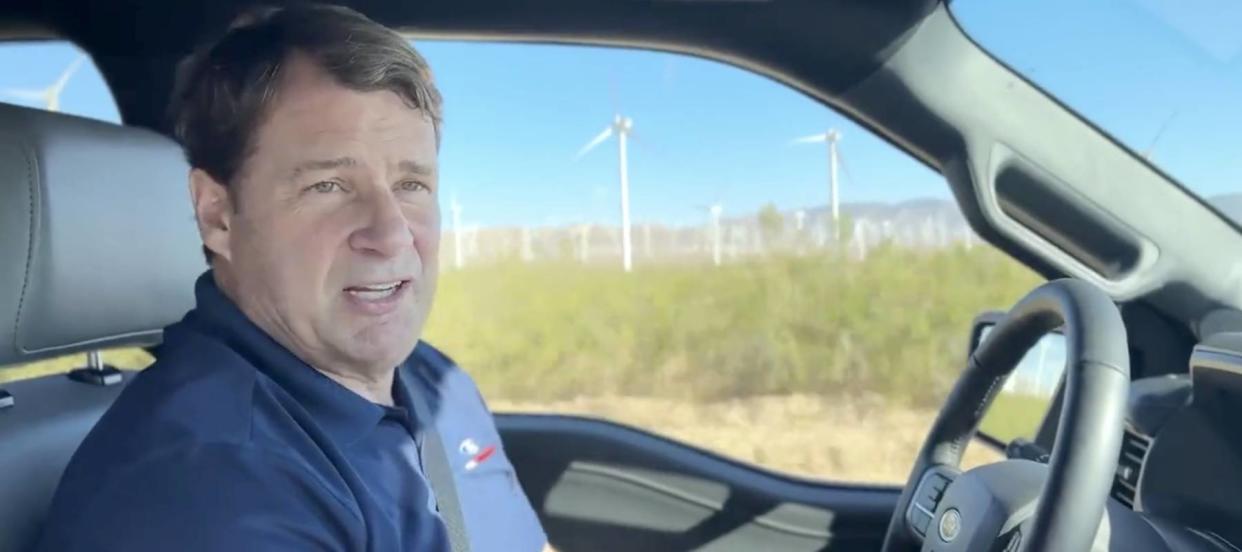'Charging has been pretty challenging': Ford CEO got a 'reality check' when he took an electric F-150 Lightning on a road trip — here are 3 big long-distance issues EV drivers face

Owning an electric vehicle (EV) isn't the stuff road trip dreams are made of, as Jim Farley realized recently.
Ford's CEO took the company's electric F-150 Lightning vehicle for a ride from Silicon Valley to Las Vegas, documenting his experiences on social media along the way.
He admitted in a video posted Aug. 13 to his account on X (formerly known as Twitter) that “charging has been pretty challenging.”
Don't miss
Commercial real estate has outperformed the S&P 500 over 25 years. Here's how to diversify your portfolio without the headache of being a landlord
Find out how to save up to $820 annually on car insurance and get the best rates possible
Finish 2023 stronger than you started: 5 money moves you should make before the end of the year
In the video, during which he’s seen at the wheel of a vehicle, he says that he had just been to a charging site along Interstate 5 in California, where he waited 40 minutes to get a 40% charge on his truck.
"It was a really good reality check of the challenges that our customers go through," Farley said.
The video was posted after a story came out Aug. 10 that a Canadian man abandoned his own F-150 Lightning he claimed failed to charge at two separate stations during a family road trip from Winnipeg to Chicago. He completed the journey in a gas-powered rental vehicle.
"Shifting from fueling stations to charging stations requires new behaviors and opens new possibilities," Farley wrote in a LinkedIn post on Aug. 7 before embarking on his cross-country journey.
Unfortunately, it seems those new behaviors may include learning greater patience and new possibilities may include catching up on your reading while you wait roadside for a full charge. Here are three of the biggest issues facing EV drivers when it comes to charging up for long trips.
Lack of charging infrastructure
Unless you use your vehicle only for short-distance trips, you'll need somewhere to recharge other than your home. But EV charging stations can be few and far between.
According to a recent study by Coast, a company that provides payment tools for vehicle-fleet owners, there are only 22 EV charging stations per 1,000 road miles in the U.S.; that’s compared to 104 gas pumps per 1,000 road miles. In many states, you won't even be able to find one charging station per 100 square miles. Moreover, many states have more registered EVs than they do charging ports. For example, the Coast study shows that Nevada has 49% more EVs than the national average but 19% fewer charging ports per square mile.
This doesn't account for the possibility that any number of these stations could be out of order, as the Canadian traveler mentioned above claimed happened to him during his trip.
Ford announced in October it would expand its EV charging network in North America by 25% to over 106,000 chargers total.
Read more: Owning real estate for passive income is one of the biggest myths in investing — but here's how you can actually make it work
Long charging times
The amount of time potentially wasted in looking for an EV charging station — and then waiting in line for your turn at the port — is only exacerbated by how long some chargers take. A fast-charging, direct-current station can charge an EV battery from empty to 80% in 20 minutes to an hour, according to the Department of Transportation. But that's still significantly longer than it takes to fill a tank with gas.
The lower-performance chargers are even worse. On a Level 2 AC charger, a step below the fastest chargers, it takes four to 10 hours to charge an EV battery to 80% from empty.
Farley posted a follow-up video to X from a fast-charging station in Baker, Calif., which he described as "quick and easy" compared to the previous one.
Range anxiety
Naturally, any EV owner taking a long trip will have to keep an eye on battery power and take note of charging stations in range, which can add anxiety while driving. It can be an even bigger concern in colder months, which can cut an EV's range due to increased power consumption. Consumer Reports found that cold weather cut the average range by about 25% when driving at 70 miles per hour. The effect of cold is even more pronounced if you're making short trips with frequent stops: in that situation, you could lose 50% of your range.
So if you do attempt a road trip with an EV, make sure you have all your charging stops mapped out and bring a good book because you could be in for a long wait.
Slash in production
Ford will cut next year's planned production of the F-150 Lightning in half, according to a memo to suppliers obtained by Automotive News. The automaker attributed the move to "changing market demand," the publication says.
What to read next
You can cash in on prime real estate for as little as $20. Here’s how.
Millions of Americans are in massive debt in the face of rising rates. Here's how to get your head above water ASAP
Rising prices are throwing off Americans' retirement plans — here’s how to get your savings back on track
This article provides information only and should not be construed as advice. It is provided without warranty of any kind.
